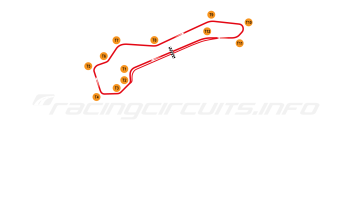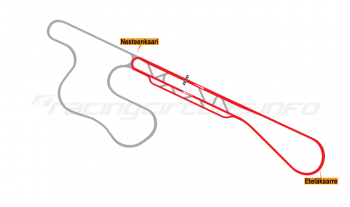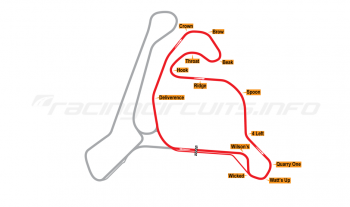Vallelunga
Circuit Overview
Hidden away in the hills north of Rome, the Autodromo Vallelunga Piero Taruffi is close to several lakes and surrounded by vineyards, making it popular with teams and drivers. Having undergone recent renovation and extension, Vallelunga is now one of the most modern circuits in Italy.
Owned by the Automobile Club d'Italia (ACI), the track is used for public driving safety training courses and, in autumn of each year, hosts a vast flea-market specialising mainly in vintage automotive spare parts.
Today, the circuit continues to host a wealth of national and local racing, a popular 6 Hour GT race, alongside separate motor testing, driving school and conferencing facilities. The track is also home to Kunos Simulazioni, developers of the Assetto Corsa racing simulator, who have an office in the pit complex. Unsurprisingly, Vallelunga is one of the included circuits within Assetto Corsa.
Circuit History
The circuit has a long heritage, initially opening in 1951 as a tiny dirt oval, converted for motor racing use from a horse racing track which had operated for a few years previously. With a tribune overlooking the course and hillside viewing opposite, it must have brought to mind images of the chariot racing which would have gone on in the area centuries before.
In late November 1951, after an initial series of motorbike meetings, the first car race took place, proving something of a contrast to the norms of road racing or the high speed blasts at Monza. Spectators loved being able to see the whole course and were treated to a diverse programme of racing, including small sportscars driven by the young aces of the day. Events were often rounded off by motorbike speedway races on the infield oval and sometimes even motocross competitions.
From dirt oval to a road course
The circuit continued to grow in stature to the point that by 1957 it was decided to convert it fully for motor racing. Italian driver and noted engineer Piero Taruffi was brought in to create a new asphalt course which provided a more suitable challenge for drivers as well as a useful test facility for manufacturers. He penned a twisty infield section within a reconfigured oval, which now featured a kinked back straight and different radius corners at each end. The circuit direction continued to run anti-clockwise.
The works to prepare new 1.085 miles / 1.746 km long, 10-metre wide 'Club' circuit began in the summer of 1957 and were quickly completed, with the first official race, the Esso 6 hours, held on December 1. Sergio Bettoja won the GT race in an Alfa Romeo Giulietta SV while Luciano Mantovani took the sportscar victory in an Osca.
In 1961 the circuit, still owned by the Pesci family, reached agreement with the Municipality of Campagnolo for a major extension, which would see the course double in length. Work to create the new 'International' course required part of a hillside to be blasted away and was a major undertaking. The 2 mile / 3.2 km course was opened in April 1963 with a non-championship Formula One race, the Grand Prix of Rome. Bob Anderson took victory in a Lola Mk4 against a fairly moribund field of which there were only three finishers in each of two heats.
ACI buys in and modernises
In 1967, the circuit passed into the ownership of the Automobile Club of Italy (ACI), which initiated a programme of modernisation in 1970. New pits – now located on the inside of the circuit – included purpose built garages and a control tower, while a tunnel now linked the outside of the circuit with the relocated paddock. This necessitated the completed rebuilding of the Rome Curve, which was now returned to something approximating the radius of the original horse racing track's bend. Elsewhere around the track there were upgrades for safety, including the addition of Armco barriers and extended run-off areas. Opposite the new pits sat a new giant grandstand complex which could seat 10,000 spectators.
The work took longer than initially expected, bad weather and Italian bureaucracy slowing it in part, and it was not until October 1971 that it was ready for racing again. The new configuration did however prove popular, with a 6 Hour sportscar race being included within the World Championship for Makes and Formula Two and, later, Formula 3000 races becoming well established. The circuit was also used as testing venue by Formula One teams and the Alfa Romeo sportscar squad. During the 1970s, motorcycle racing also moved to the fore, with the Roman circuit becoming a staple of the Italian championship races.
The 1971 renovations would see the track layout remain largely unaltered until 1987, when a pair of chicanes were added for use by motorcycle racers, also resulting in the creation of a new north loop which could be run simultaneously with the 'Club' course. The northern loop was modified several times in subsequent years, with the incorporation of a new infield section which could also be run independently, known (perhaps somewhat confusingly) as the 'West' course.
Major refurbishment and extension completed
Once a regular host of Formula 2 and Formula 3000, Vallelunga had fallen out of favour with the major car racing series by the beginning of the millennium, although it did host a poorly-attended round of the European Le Mans Series in 2001. A major refurbishment was proposed in 2004 and some resurfacing and preliminary works were carried out for the beginning of the 2005 series, while construction continued on a new 1km extension.
By the summer of 2005, the new extension was complete. The full course now turned left after the Cimini corners, heading down a lengthy straight to a 180 degree hairpin, returning back to the original course via a sharp left hander. A chicane was introduced at Trincea for motorbikes, while new pit buildings and a revised pit entry also debuted. Considerable other improvements were made to run-off areas around the track to bring it up to modern standards. The revised course effectively spelled the end of the old 'International' layout, with parts sealed off behind barriers, though its asphalt remains and it could be pressed into action if required in future.
The changes brought about the arrival of the World Superbike Championships for two years in 2007 and 2008, while the circuit was also licensed for Formula One testing, Anthony Davidson setting the outright lap record at 1m12.80s in a Honda RA 106.
In 2006, the circuit was dedicated in the memory of its original designer, officially becoming the Autodromo Vallelunga Piero Taruffi.
Jump onboard
Circuit info
- Autodromo di Vallelunga, ACI Sport SpA, 00063 Camagnano di Roma, Italy
- 39 06 9015501
- Email the circuit
- Official website
Rate This Circuit
Votes: 6018
Plan a visit
Get your race tickets!
Brought to you with: 
We've teamed up with Motorsports Tickets to bring you the best deals for Formula One, MotoGP, Le Mans and more.



































